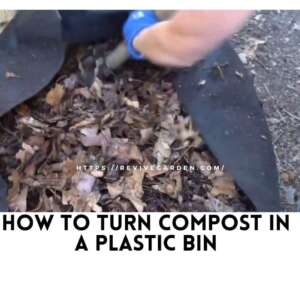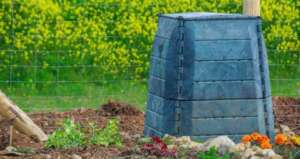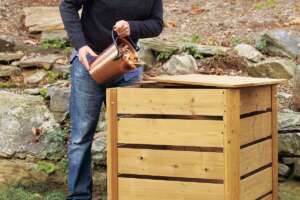Table of Contents
Composting isn’t for everyone, but it is the most eco-friendly way to deal with your yard and garden waste. But some may find themselves going through bins quickly. That can eventually lead to odour and unpleasantness. Consider this your guide to turning compost into a plastic bin.
 How to turn compost in a plastic bin – New age ways
How to turn compost in a plastic bin – New age ways
Compost bins are an excellent way to keep composting organised and efficient. If you have a large amount of organic material, you may want to use a larger bin to handle more waste. However, if you have just a few scraps to compost each week, it might be easier to use a smaller container.
Composting is as easy as combining different types of organic material in one place and letting them rot naturally. The process takes time, but it can pay off when you have rich soil for your plants or flowers.
What is compost?
Composting is a great way to recycle food scraps, yard waste and other organic materials. By composting, you’re helping the environment by recycling your scraps into a nutrient-rich substance that can be used in your garden or lawn.
Composting is a great way to recycle food scraps and other organic materials. It can also be used as a soil conditioner, fertiliser and even a fuel source in some cases. But it can be difficult to keep the composting process going if you have a small backyard or limited space.
What type of plastic is best for making compost?
Different types of plastic can be used for making compost bins and containers. Polyethylene (PE) or high-density polyethylene (HDPE) are two common types of plastic found in everything from water bottles to flower pots and buckets. They are relatively inexpensive and durable but will degrade over time if exposed to UV light and oxygen. Both PE and HDPE plastics are considered safe for food contact by the FDA, so they’re good choices if you want to use your bin for kitchen scraps and yard waste or other non-food items like paper or cardboard.
Can you put compost in a plastic bin?
Yes, you can put compost in a plastic bin. However, the same rules apply to any other composting system. If your compost is too wet or has too much nitrogen, it will not be able to break down properly and will end up smelling bad and attracting pests and vermin.
How to prepare a plastic bin for turning compost?
If you want to turn the compost in a plastic bin, you must have holes that may cause air circulation into the bin so that you compost make well; otherwise, it will not get dry and leave a smell. You must decompose your material, either its kitchen wastes or leaves or animal wastes, for composting. You drill holes throughout your container. Space could be 1 to 2 inches apart.
Best choice for a compost container
It depends on what kind of plastic bin you’re using. Some compost bins are made from opaque materials and will not allow light to reach the compost. If this is the case, you need to turn your compost to allow air circulation and oxygenation (which are two important parts of making good soil).
The best way to do this is by turning it over with a pitchfork or shovel. However, if you want to avoid doing this every week or so, there are other options. You can purchase a tumbling composter that turns itself every few days or try one of the automatic compost turners that automatically turn your bin. You’ll have to research different models because they all work differently.
Why Is Turning Compost Important?
Turning compost can help prevent anaerobic conditions (when there is no oxygen available) in your bin. An anaerobic environment leads to bad odours and poor compost quality.
It also helps ensure that all the organic matter in your bin is mixed well so that there are no pockets of undecomposed material.
What is the right size for a compost bin?

The right size of compost bin will depend on how much compost you’ll be producing and the space you have available. If you’re new to composting, start with a smaller container and then upgrade to a larger one.
How to use a large bin?
A simple container can be turned by hand, but larger bins may require a pitchfork or shovel. If you have a large chest, it’s best to turn it once or twice a week to keep the contents aerated. For smaller bins, turning every few days is sufficient.
Create your Homemade Compost bin

Composting bins don’t need to be fancy or expensive. They need to be functional — and easy to use. Here are some ideas for cheap and simple DIY compost bins that anyone can make at home.
- A basic bin made from pallets
- A barrel with holes drilled in the bottom
- A garbage can with holes drilled in the bottom
- A stack of logs with a cut-out top
- Homegrown recycled products like pallets or old tires
DIY
Create a bin out of PVC pipe. Cut two 18-inch pieces of 4-inch PVC pipe and two 12-inch pieces from the same size pipe. Use the 12-inch pieces to connect the other two parts to form a box shape with an open top and bottom. Drive stakes into the ground on either side of the bin and secure it with ropes or bungee cords to remain open on both sides.
Useful tips
There are many ways to compost, but one of the most popular methods is using a bin or tumbler. If you’re considering buying a compost tumbler, here are some useful tips to help you get started:
- Choose a size that will fit your needs. If you’re just beginning, an inexpensive plastic bin with a lid is a good place to start. They’re easy to use and can be stored when not in use. You can also build your own wooden bins if you’re handy with tools and want something more permanent.
- Consider buying one with wheels so it’s easier to move around your yard or garden. You’ll also want one that has some sort of handle so it’s easy to carry when full of compostable materials. Depending on how much material you plan on composting at once, this may not be an issue for you – but it’s still nice to have the option!
- Buy enough materials for your compost bin as well as any accessories like thermometers or moisture gauges so everything is ready when it arrives at your home!
- Use sticks, forks, and spoons. If you don’t have any pitchforks or shovels lying around, try using sticks (or even twigs) instead. They’ll do the trick just as well as any other tool. You can also use wooden spoons as long as they’re sturdy enough not to break off while stirring up the pile.
- If you have access to one, using a garden cart or wheelbarrow will make turning your compost much easier than using just sticks and spoons alone!
Final words
Composting is a great way to reduce your waste and provide nutrients for your garden. This article showed how to turn the compost into a plastic bin. If you want to start composting but aren’t sure how this is a great place to start. For more information on composting and other ways to reduce your waste, open the information below.
